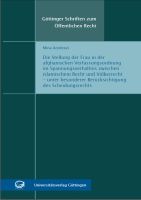Die Stellung der Frau in der afghanischen Verfassungsordnung im Spannungsverhältnis zwischen islamischem Recht und Völkerrecht
unter besonderer Berücksichtigung des Scheidungsrechts
| dc.contributor.author | Aryobsei, Mina | |
| dc.date.accessioned | 2020-04-15T02:41:26Z | |
| dc.date.available | 2020-04-15T02:41:26Z | |
| dc.date.issued | 2014 | |
| dc.identifier.uri | http://library.oapen.org/handle/20.500.12657/37089 | |
| dc.description.abstract | After the fall of the Taliban, the new Afghan constitution of 2004 marks a fundamental beginning for the status of women – at least from a normative perspective. Art. 22 of the Afghan constitution contains: “The citizens of Afghanistan, man and woman, have equal rights and duties before the law.” According to Art. 7 of the constitution the state shall observe i. a. the international treaties to which Afghanistan has joined. This also covers the Convention on the Elimination of All Forms of Discrimination against Women. At the same time, Art. 3 of the constitution provides that no law should contravene the tenets and provisions of the holy religion of Islam in Afghanistan. But how do these different sources of law interact in conflicting legal fields? There are no exiting provisions of the constitution explicitly offering an answer to this problem. This work focuses on the solution of this question regarding the status of women, especially in the law of divorce. | |
| dc.language | German | |
| dc.subject.classification | thema EDItEUR::L Law | en_US |
| dc.subject.classification | thema EDItEUR::L Law::LA Jurisprudence and general issues::LAF Systems of law::LAFS Systems of law: Islamic law | en_US |
| dc.subject.classification | thema EDItEUR::L Law::LA Jurisprudence and general issues::LAQ Law and society, sociology of law::LAQG Law and society, gender issues | en_US |
| dc.subject.classification | thema EDItEUR::L Law::LN Laws of specific jurisdictions and specific areas of law | en_US |
| dc.subject.other | Afghanistan | |
| dc.subject.other | Conflict of laws | |
| dc.subject.other | Status of women | |
| dc.subject.other | Divorce Law | |
| dc.subject.other | Constitutional provisions | |
| dc.subject.other | Islam | |
| dc.title | Die Stellung der Frau in der afghanischen Verfassungsordnung im Spannungsverhältnis zwischen islamischem Recht und Völkerrecht | |
| dc.title.alternative | unter besonderer Berücksichtigung des Scheidungsrechts | |
| dc.type | book | |
| dc.type | book | |
| oapen.identifier.doi | 10.17875/gup2014-777 | |
| oapen.relation.isPublishedBy | ffaff15c-73ed-45cd-8be1-56a881b51f62 | |
| oapen.description.otherlanguage | Nach dem Sturz der Taliban markiert die neue afghanische Verfassung aus dem Jahre 2004 einen fundamentalen Neuanfang für die Stellung der Frau – zumindest aus normativer Sichtweise. Art. 22 der afghanischen Verfassung lautet: „Die Bürger Afghanistans, sowohl Frauen als auch Männer, haben vor dem Gesetz gleiche Rechte und Pflichten“. Gemäß Art. 7 der Verfassung hat der Staat u.a. die Allgemeine Menschenrechtserklärung und die von Afghanistan ratifizierten Verträge zu achten. Dazu zählt auch das Übereinkommen zur Beseitigung jeder Form der Diskriminierung der Frau. Hingegen legt Art. 3 der Verfassung fest, dass kein Gesetz dem Glauben und den Bestimmungen der heiligen Religion des Islam widersprechen darf. Doch in welchem Verhältnis stehen diese Rechtsquellen im Falle einer Normenkollision? Explizite Verfassungsbestimmungen hierzu existieren nicht. Im Zentrum der Untersuchung der vorliegenden Arbeit steht die Klärung dieses Verhältnisses betreffend die Stellung der Frau, im Speziellen im Scheidungsrecht. |

